HP HPE0-Y53 Building HPE SDN and FlexNetwork Solutions Online Training
HP HPE0-Y53 Online Training
The questions for HPE0-Y53 were last updated at Dec 19,2025.
- Exam Code: HPE0-Y53
- Exam Name: Building HPE SDN and FlexNetwork Solutions
- Certification Provider: HP
- Latest update: Dec 19,2025
Refer to the exhibit.
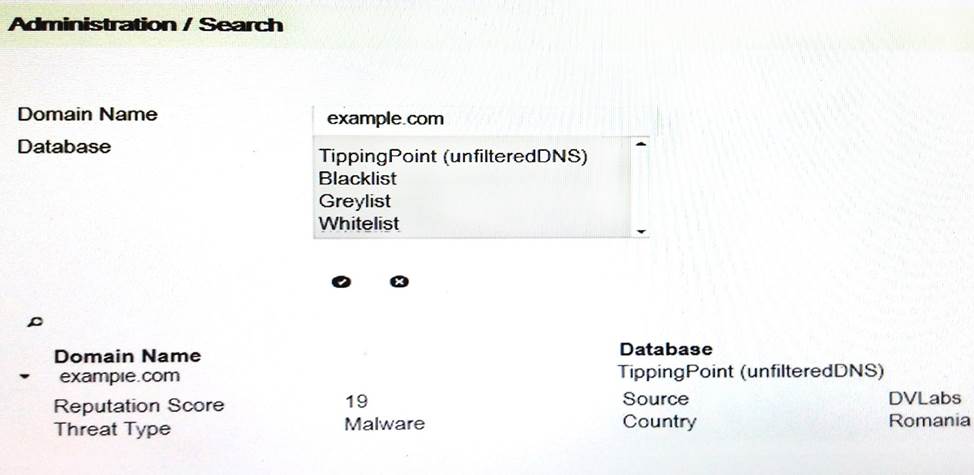
A company is using HP Network Protector SDN Application with the default RepDV filters. The rest of the configuration is at default. A network administrator wants to determine whether the HP Network Protector application will deny access to a web site.
The administrator searches for the domain name and receives the result shown in the exhibit.
What can the administrator determine?
- A . The application will not block access to the web site at any time or log any messages.
- B . The application will not block access to the web site at any time, but it will log attempts to access it.
- C . The application will block access to the web site and log attempts to access it.
- D . The application will block access to the web site during business hours but not at other times.
Refer to the exhibit.

A network administrator has set up MPLS on the switches shown in the exhibit. The administrator wants to verify that PE-1 can use MPLS to forward traffic to Site 3, as well as see the labels used along the path.
Which step should the administrator take to obtain this information?
- A . Run a tracert to an IP address at Site 3 using the MPLS option.
- B . Use the display command to view MPLS LDP neighbors.
- C . Debug LDP and ping an IP address at Site 3.
- D . Use the display command to view MPLS Label Forwarding Information Base (LFIB).
A company is using MCE to create a multi-tenant data center solution. Network administrators want to isolate all management functions in a VPN instance “Management”. Each switch has an IP address in 10.0.2.0/24 on its Management Ethernet port, and HP IMC manages the switches on these IP addresses. Administrators assign the Management Ethernet interfaces to the “Management” VPN instance. IMC begins losing data from the switches.
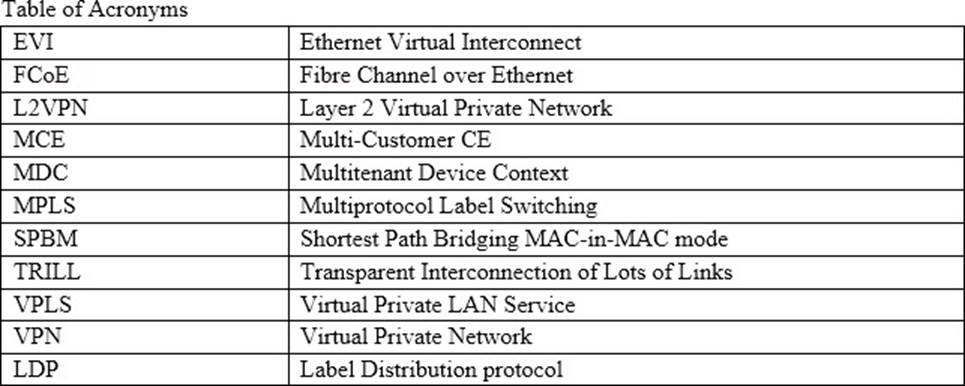
How should administrators fix the problem on each switch?
- A . Enable route leaking globally.
- B . Create a static or dynamic route to 10.0.2.0/24 in the public VPN table.
- C . Specify VPN instance “Management” for management settings such as SNMP trap destination.
- D . Set VPN instance “Management” as the default VPN instance.
A customer has five data centers. Each data center hosts 10 tenants and separates the tenants using
VLAN assignments.
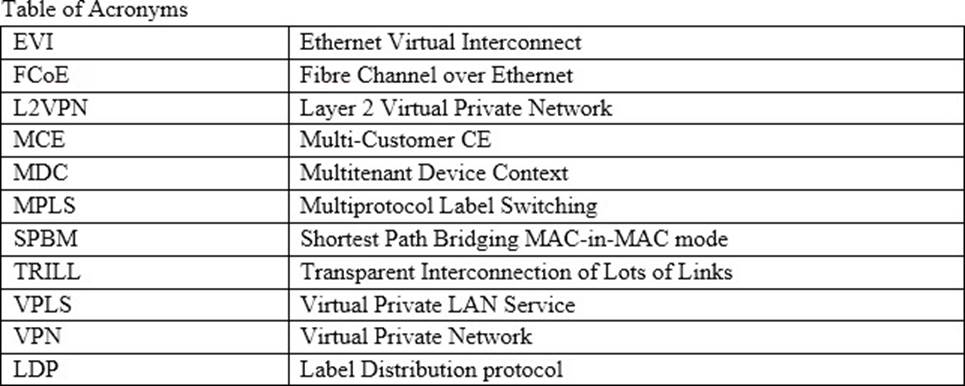
The network administrator is connecting the data centers using EVI.
How should the administrator separate the tenant traffic over the EVI links?
- A . Set up a QinQ subinterface for each tenant on the EVI tunnel interfaces.
- B . Set up a unique EVI network ID for each tenant and extend that tenant’s VLANs over that EVI network.
- C . Set up a routed subinterface for each tenant on the EVI tunnel interfaces.
- D . Extend all VLANs over the same EVI network. Use EVI VLAN mapping to map each tenant’s VLANs to a unique S-VLAN.
Refer to the exhibit.

A network administrator wants to create a leaf and spine topology.
How should the administrator connect the switches for the best latency and load-balancing?
- A . Connect each leaf switch to each spine switch, and run a protocol such as EVI.
- B . Connect each leaf switch to half of the spine switches, and run a protocol such as TRILL.
- C . Connect each leaf switch to each spine switch, and run a protocol such as TRILL.
- D . Connect each leaf switch to half of the spine switches, and run a protocol such as EVI.
Refer to the exhibit.

The switches in the exhibit are using SPBM. An administrator wants to send CustomerA traffic directly over the new link, shown by the dotted line in the exhibit, as a premium service for that customer. The existing links will be used for backup. The new link is reserved for CustomerA traffic.
How does the administrator set up Switch 1 to help to achieve this goal?
- A . by assigning the CustomerA interfaces and the specific links in the path to the same S-VLAN ID
- B . by creating a PW connection between Switch 1 and Switch 3, and mapping the CustomerA service instance to that PW
- C . by setting up a new B-VLAN and assigning it to the new link and the backup links, and mapping the CustomerA I-SID to that B-VLAN
- D . by changing the CustomerA I-SID 255 and defining the interface for the reserved link as the priority path in I-SID 255
Refer to the exhibit.
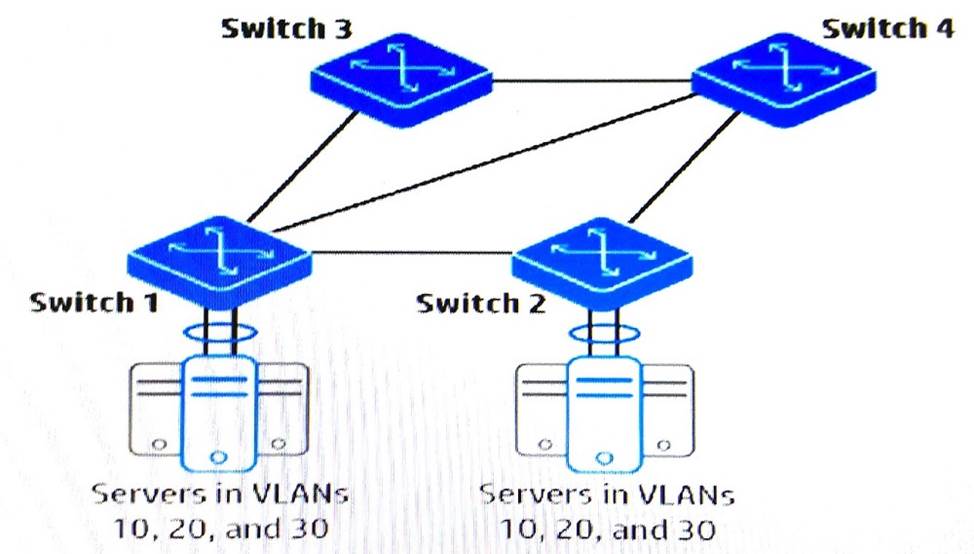
The switches shown in the exhibit form a TRILL region. The network administrator has enabled TRILL.
What helps to ensure that Switch 2 sends multicasts and broadcasts over both of its switch-to-switch links?
- A . Configure a switch to be the tree root bridge and allow the creation of multiple trees.
- B . Configure Switch 3 and Switch 4 with the same designated routing bridge (DRB) priority.
- C . Configure Switch 2 with multiple MSTP instances, which are mapped to TRILL access VLANs.
- D . Configure Switch 2 to enable TRILL Equal Cost Multi-Path (ECMP) globally.
A network administrator has installed an SDN application from the HP SDN AppStore on the HP VAN SDN Controller. If the application is running and ready to service requests, which status should the administrator see in the controller’s Applications window?
- A . RUNNING
- B . ACTIVE
- C . STARTED
- D . UP
A company has a data center that hosts multiple tenants. The company is adding a second and third data center. The core of each data center is an IRF virtual switch.
These are the IRF connections:
– IRF 1 is the core of the first data center.
– IRF 2 is the core of the second data center.
– IRF 3 is the core of the third data center.
– The three data centers are fully interconnected with dark fiber.
– IRF 1, IRF 2, and IRF 3 have connections to a WAN and to the Internet.
Which option for the connections between the data centers provides the best resiliency and stability?
- A . a link aggregation that consists of all of the links
- B . MSTP running on the links
- C . IRF 1, IRF 2, and IRF 3 combined into a single IRF virtual device
- D . SPBM configured across IRF 1, IRF 2, and IRF 3
Refer to the exhibit.
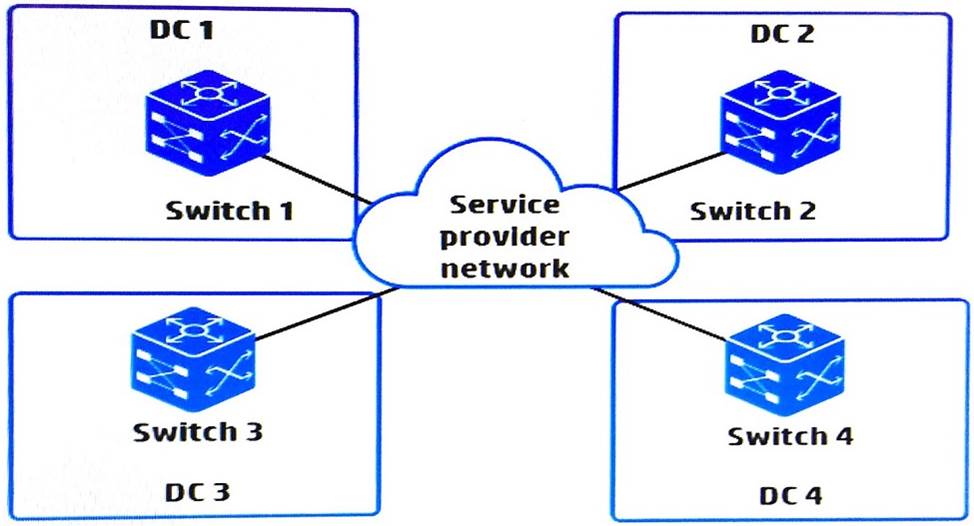
A network administrator wants to connect four data centers using HP EVI.
What is the correct setup for the EVI tunnel interfaces?
- A . three EVI tunnel interfaces on each EVI edge device―one EVI tunnel interface is required for each GRE tunnel in the mesh
- B . three EVI tunnel interfaces on Switch 1, which will act as the hub, and one EVI tunnel interface each on the other switches
- C . one EVI tunnel interface on each EVI edge deviceCthe devices automatically establish GRE tunnels between these interfaces
- D . one EVI tunnel interface on Switch 1, which will be configured as the ENDP server, and no interfaces on the other switches
Latest HPE0-Y53 Dumps Valid Version with 105 Q&As
Latest And Valid Q&A | Instant Download | Once Fail, Full Refund

